 Despite extensive research over many years, the present whereabouts of Jefferson's original Native American collections are unknown today. The Thomas Jefferson Foundation, in collaboration with the Peabody Museum of Archaeology and Ethnology at Harvard University, has turned this mystery into an opportunity to involve Native Americans in a contemporary arts project. Indian artists preserving traditional media were commissioned to create new pieces for the Indian Hall exhibition, based on primary source documentation of the room and study of surviving historical objects, most notably the Lewis and Clark collection at the Peabody Museum, which facilitated the artists’ examination of these important pieces. The artists involved in the project were Mary Elk (Mandan-Hidatsa), Dennis Fox (Mandan-Hidatsa), Mark McBride (Blackfeet), JoEsther Parshall (Cheyenne River Lakota), Joel Queen (Cherokee), and Butch Thunder Hawk (Hunkpapa Lakota).
Despite extensive research over many years, the present whereabouts of Jefferson's original Native American collections are unknown today. The Thomas Jefferson Foundation, in collaboration with the Peabody Museum of Archaeology and Ethnology at Harvard University, has turned this mystery into an opportunity to involve Native Americans in a contemporary arts project. Indian artists preserving traditional media were commissioned to create new pieces for the Indian Hall exhibition, based on primary source documentation of the room and study of surviving historical objects, most notably the Lewis and Clark collection at the Peabody Museum, which facilitated the artists’ examination of these important pieces. The artists involved in the project were Mary Elk (Mandan-Hidatsa), Dennis Fox (Mandan-Hidatsa), Mark McBride (Blackfeet), JoEsther Parshall (Cheyenne River Lakota), Joel Queen (Cherokee), and Butch Thunder Hawk (Hunkpapa Lakota).
Recreated Native American Artifacts
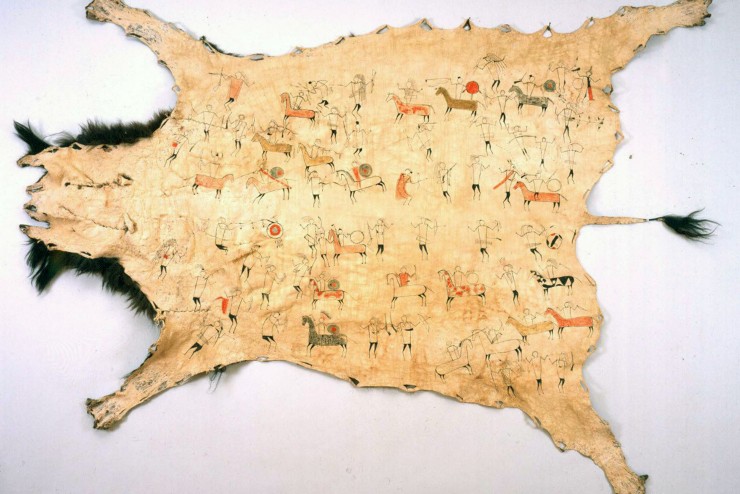
Buffalo Robe Painted with Pictographic Battle Scene
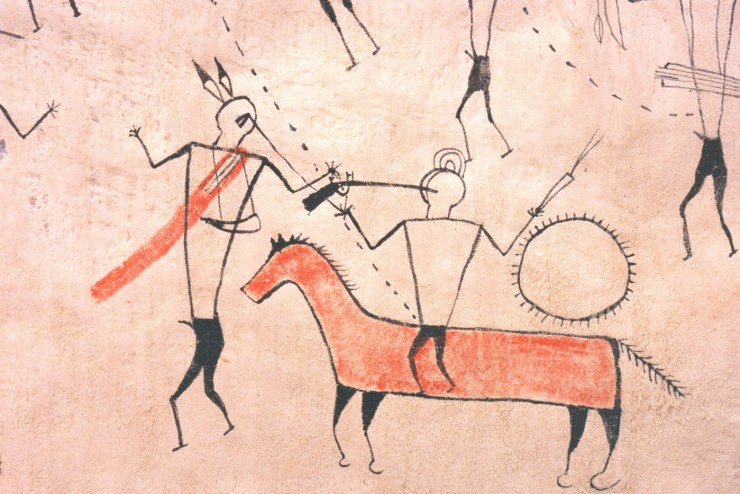
Detail of Pictographic Buffalo Robe
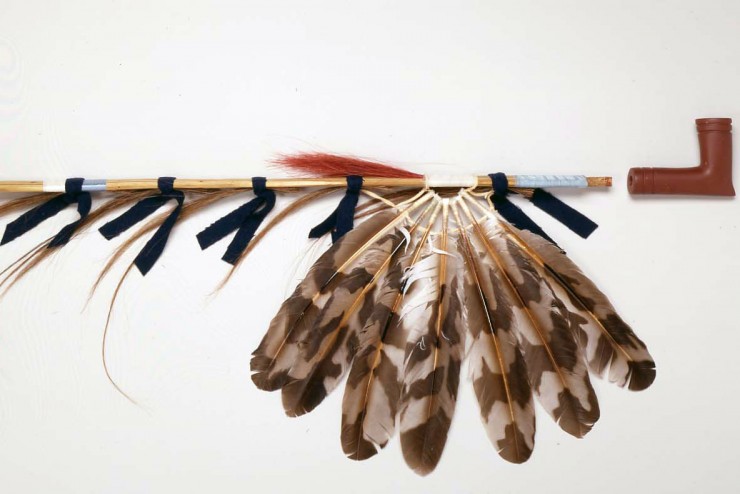
Native American Pipe Stem and Bowl (#2)
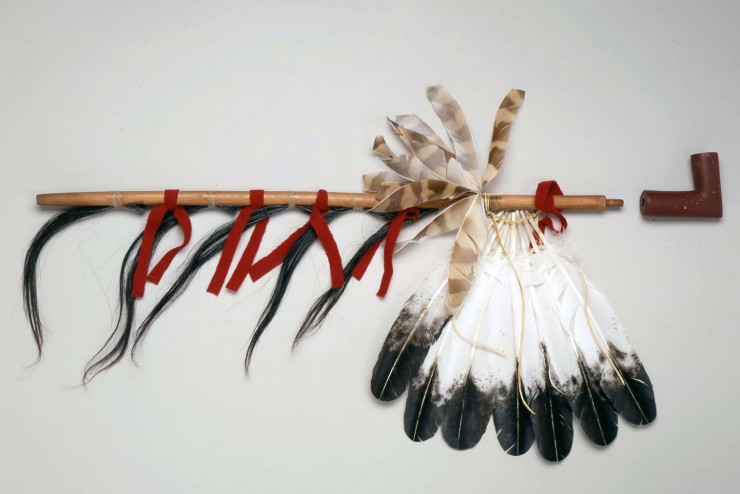
Native American Pipe Stem and Bowl (#1)
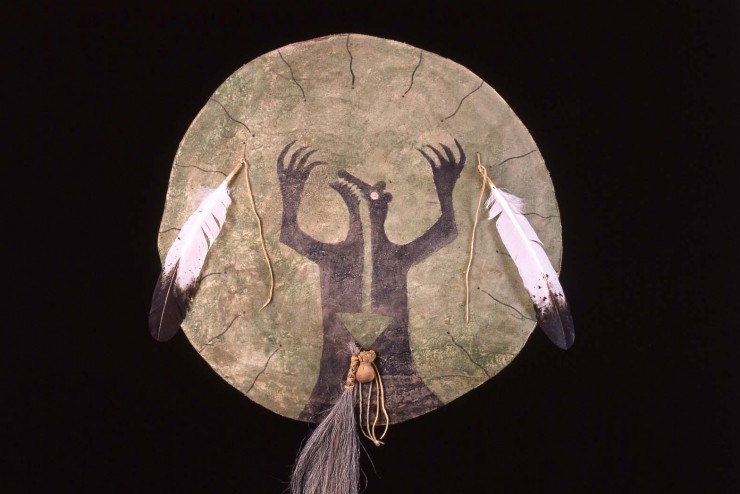
Native American Shield with Bear Motif
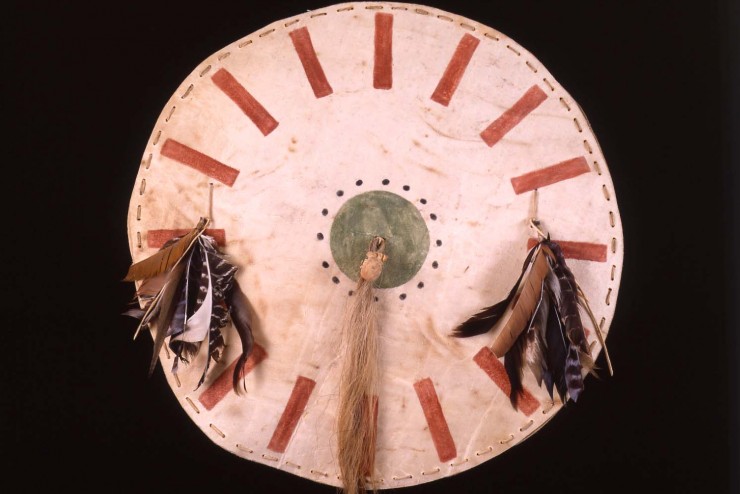
Native American Shield (with geometric forms)
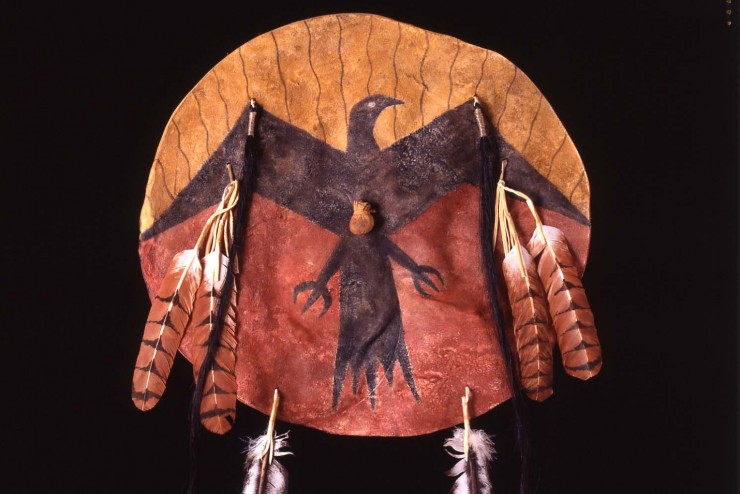
Native American Shield with bird motif
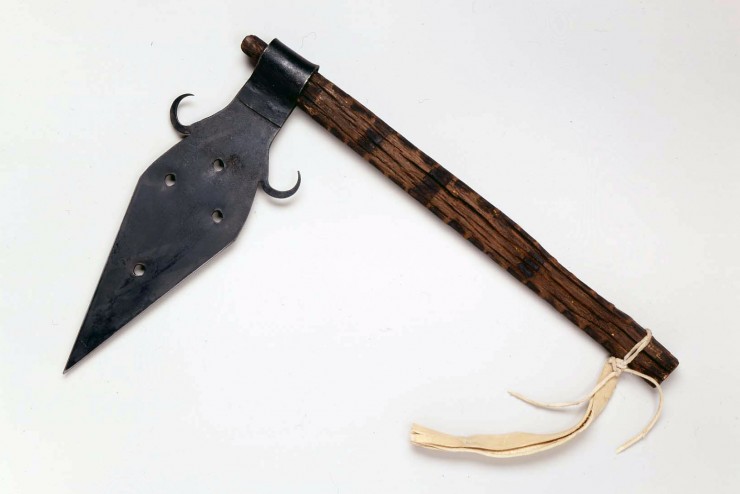
Native American Pipe Tomahawk

Native American Gunstock Club
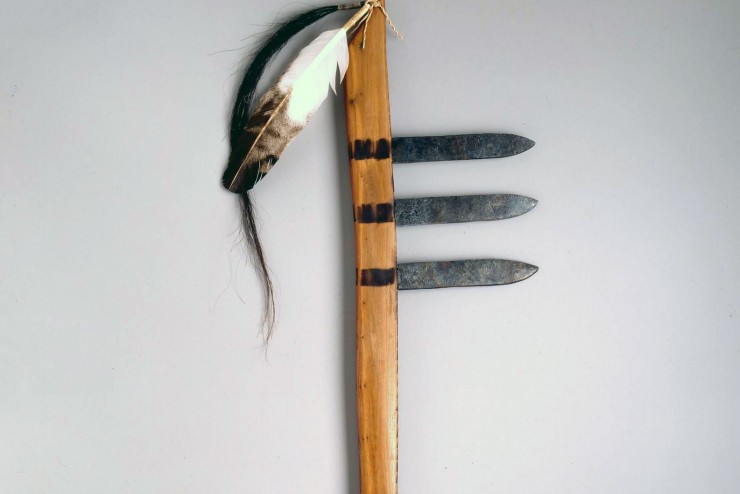
Native American War Club (#1)
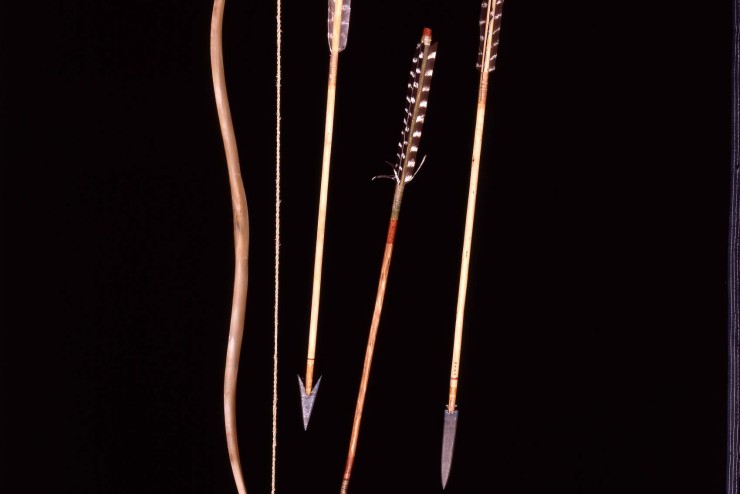
Native American Bow and Arrows

Native American Lance (#2)
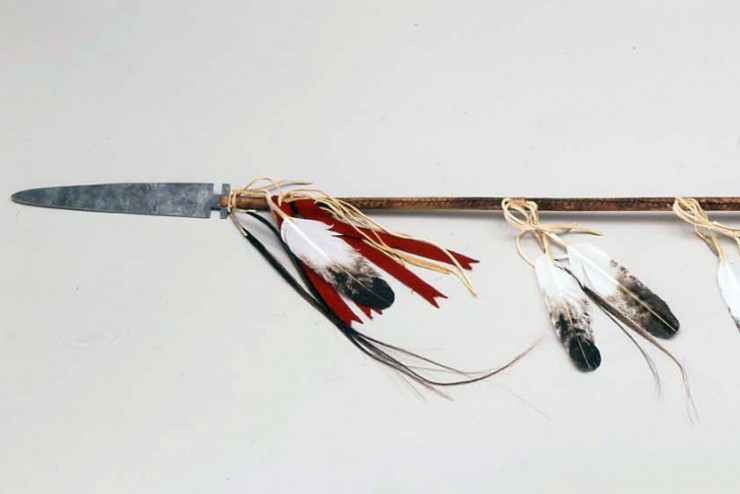
Native American War Club (#1)
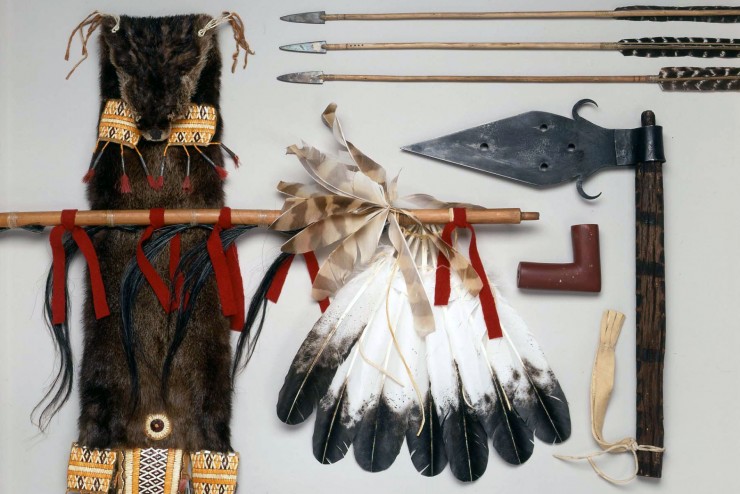
Vignette of various objects from the Recreated Indian Hall at Monticello
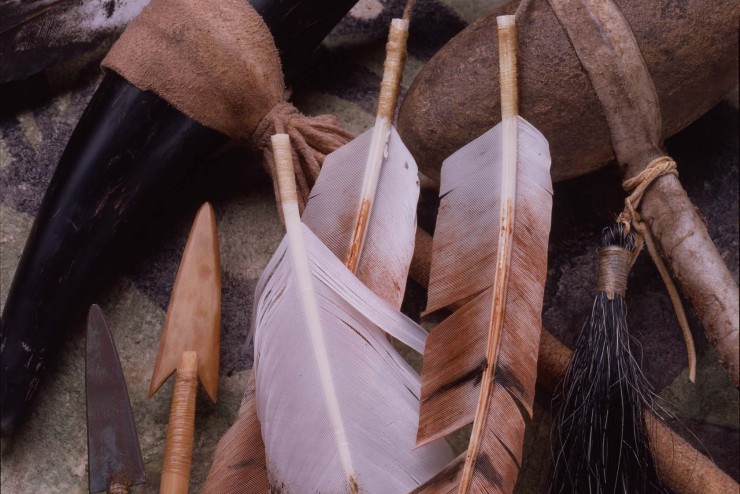
Detail of Shield, Arrows, and Club Heads
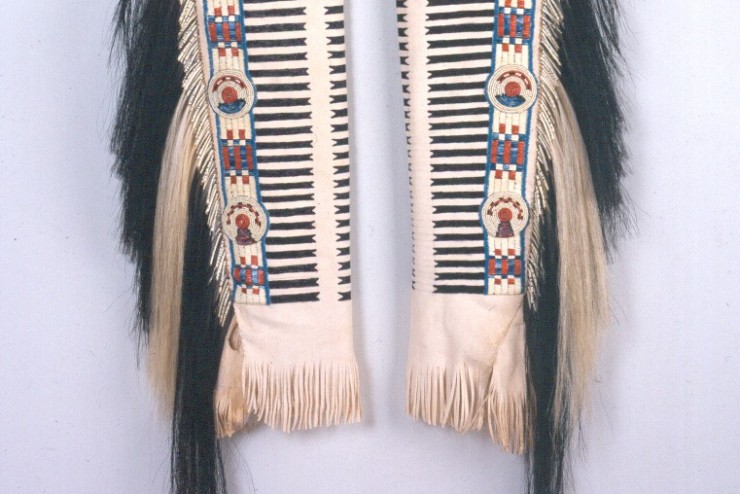
Detail of Leggings with Quill Work
Weaponry
Visitors to Jefferson's "Indian Hall" reported seeing "offensive and defensive weapons" among the Native American collections. Clubs with wooden handles and heads made from stones or horns were traditional weapons on the Northern Plains. They later became important ceremonial objects as other types of weapons, such as bows, arrows, lances, and clubs with metal blades became more common. Clubs at the time of the Expedition were decorated simply with feathers and horsehair. Round shields made from the thick hide of a buffalo's hump were painted with stylized symbols derived from dreams or visions that protected warriors in battle. An honored warrior would decorate a shield with eagle feathers representing great deeds of bravery.
Hide Painting
The art of hide painting is used to create the painted hide robes that were traditionally a common garment for the Native men and woman of the Great Plains. Painted robes also became customary diplomatic gifts and articles of trade. Robes could contain figurative or abstract designs. Men's robes often contained representations of battles in which they had distinguished themselves. Lewis and Clark recorded receiving a robe from the Mandan chief Black Cat. The Ft. Mandan shipment to Jefferson contained seven buffalo robes, including the battle robe that he sent to Monticello. This robe depicted a conflict in which the Mandan and their Hidatsa allies fought the Lakota and the Arikara. To make a painted robe, a buffalo, elk, deer, cow, or horse hide was stretched, scraped, and tanned in a solution containing the animal's brain. After being tanned, the surface to be painted was stretched further to render it smooth and flat. Natural pigments were mixed with water and a hide glue binding agent and applied with a porous buffalo bone.
Pipes
The ritual use of tobacco is central to many Native American cultures. On the American frontier pipe ceremonies became a means through which peaceful intentions were expressed. Pipes and smoking played an important role in the diplomatic encounters Lewis and Clark had with native people along the trail. Clark described the ritual of smoking as "the greatest mark of friendship and attention." Pipes were also important diplomatic gifts symbolizing the relationships that smoking together cemented. A pipe consists of a long hollow wooden stem sometimes decorated with eagle feathers, horsehair, or quillwork, and a separate carved stone bowl that held the tobacco. Jefferson sent two pipes to Monticello in March 1806.
Quillwork
Traditionally practiced by Native women in the Eastern Woodlands, Great Lakes and Plains regions, quillworking is an intricate form of embroidery that employs dyed porcupine quills that are wrapped, plaited, sewn, and woven using a wide range of techniques. Quillwork is used to embellish many different types of clothing and domestic and ceremonial objects, including leggings, moccasins, shirts, dresses, buffalo robes, bags, knife sheaths, baskets, baby cradles, wooden handles, tipis and pipe stems. On the Northern Plains a young woman must earn the right to do quillwork within a quillwork society by offering gifts to an elder woman in exchange for instruction in the techniques and rituals. Through quillwork societies the art has been guarded, preserved, and passed down through the generations; it survives today in many contemporary forms.
Artists
 Mandan-Hidatsa hide painter Dennis Fox is the Director of the Independence Program for the Three Affiliated Tribes (Mandan, Hidatsa, Arikara) of Fort Berthold in New Town, North Dakota. He studied at the University of Maryland and worked for the Smithsonian Institution's Folklife Program in Washington, D.C. His interest in traditional Northern Plains hide painting developed during his youth in South Dakota and later in New Town. He realized that he wanted to know how to paint in the manner of his forebears and researched painting techniques at the North Dakota Heritage Center. His work is also in the collection of the Smithsonian Institution's National Museum of American History.
Mandan-Hidatsa hide painter Dennis Fox is the Director of the Independence Program for the Three Affiliated Tribes (Mandan, Hidatsa, Arikara) of Fort Berthold in New Town, North Dakota. He studied at the University of Maryland and worked for the Smithsonian Institution's Folklife Program in Washington, D.C. His interest in traditional Northern Plains hide painting developed during his youth in South Dakota and later in New Town. He realized that he wanted to know how to paint in the manner of his forebears and researched painting techniques at the North Dakota Heritage Center. His work is also in the collection of the Smithsonian Institution's National Museum of American History.
For "Framing the West at Monticello," Dennis recreated two well-documented pieces from Jefferson's collection that are no longer at Monticello: a pictographic battle robe that William Clark described in 1805 as "1 Buffalow robe painted by a Mandan man representing a battle which was faught 8 years since, by the Sioux & Ricaras, against the Mandans, Minitarras & Ahwahharways," and a Native American map painted on a hide that represented the Missouri River and its tributaries between the Platte and Yellowstone Rivers. In preparation for painting the battle robe, Dennis studied the famous pictographic battle robe in the collection of the Peabody Museum of Archaeology and Ethnology at Harvard. He also studied Indigenous cartographic techniques in books and learned about them from his tribal elders.
The hides Dennis painted were brain-tanned by Ken Woody, Director of Interpretation at Little Bighorn Battlefield National Monument in Crow Agency, Montana. In this traditional manner for preparing hides for painting, the skin is soaked in a solution that includes the animal's brain.
 The quillwork of JoEsther Parshall has won numerous awards, including the prestigious Best in Show at the Northern Plains Tribal Arts Exposition. Parshall, a Cheyenne River Lakota, earned her quillworking rights from Mandan-Hidatsa quillworker Carrie Brady on the Ft. Berthold Reservation in North Dakota. She is also a highly accomplished seamstress. Her quillwork is in several museum and private collections, including the South Dakota Historical Society, the Northern Plains Tribal Arts Museum, the National Museum of Scotland, and the Peabody Museum of Archaeology and Ethnology at Harvard.
The quillwork of JoEsther Parshall has won numerous awards, including the prestigious Best in Show at the Northern Plains Tribal Arts Exposition. Parshall, a Cheyenne River Lakota, earned her quillworking rights from Mandan-Hidatsa quillworker Carrie Brady on the Ft. Berthold Reservation in North Dakota. She is also a highly accomplished seamstress. Her quillwork is in several museum and private collections, including the South Dakota Historical Society, the Northern Plains Tribal Arts Museum, the National Museum of Scotland, and the Peabody Museum of Archaeology and Ethnology at Harvard.
JoEsther used porcupine quills dyed by Jan Zender and Rochelle Dale using madder root (red), bloodroot (yellow-orange), and indigo (blue). Zender and Dale are non-Native artists who replicate early frontier arts including quillwork, silverwork, and canoe-making. They live in the woods of northern Michigan where they gather many of their materials in nature and are preserving important techniques like the natural dying of porcupine quills for traditional quillwork.
 Butch Thunder Hawk is a Hunkpapa Lakota artist originally from Cannonball, North Dakota on the Standing Rock Reservation. He graduated from Dickinson State University in North Dakota and attended the California College of Art and Crafts in Oakland, California. Thunder Hawk also studied tribal arts, including pipemaking, with elders at Standing Rock. He has taught tribal arts at United Tribes Technical College in Bismarck, North Dakota, since the late 1970s. Many of the pieces for Monticello were created during a special summer session held in 2001 in which Butch and his students studied historic objects in the Peabody Museum of Archaeology and Ethnology at Harvard University and the North Dakota Heritage Center, gathered wood, rocks, earth pigments and other materials, and made clubs, lances, and arrows. Butch also created shields, two pipes, and a quiver and bowcase for the project.
Butch Thunder Hawk is a Hunkpapa Lakota artist originally from Cannonball, North Dakota on the Standing Rock Reservation. He graduated from Dickinson State University in North Dakota and attended the California College of Art and Crafts in Oakland, California. Thunder Hawk also studied tribal arts, including pipemaking, with elders at Standing Rock. He has taught tribal arts at United Tribes Technical College in Bismarck, North Dakota, since the late 1970s. Many of the pieces for Monticello were created during a special summer session held in 2001 in which Butch and his students studied historic objects in the Peabody Museum of Archaeology and Ethnology at Harvard University and the North Dakota Heritage Center, gathered wood, rocks, earth pigments and other materials, and made clubs, lances, and arrows. Butch also created shields, two pipes, and a quiver and bowcase for the project.
 Butch and his students used mane and tail hair from Nokota horses to embellish the objects they created. Nokota horses formerly ran wild in the Little Missouri badlands of western North Dakota and are descended from early Native and ranch stock. They have been designated North Dakota’s “honorary equine” or state horse. For more information on the Nokota horses, including Target, whose tail hair hangs from the green shield in the Indian Hall, see www.nokotahorse.org.
Butch and his students used mane and tail hair from Nokota horses to embellish the objects they created. Nokota horses formerly ran wild in the Little Missouri badlands of western North Dakota and are descended from early Native and ranch stock. They have been designated North Dakota’s “honorary equine” or state horse. For more information on the Nokota horses, including Target, whose tail hair hangs from the green shield in the Indian Hall, see www.nokotahorse.org.
